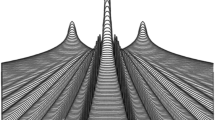Abstract
In this paper we suggest that theories treating two interacting objects in a different manner (for instance electromagnetic field of a laser classically, and the interacting atom as a quantum object) should be called “mixed”. Mixed theories are not so rare in Physics. One just should look at the whole area of Atomic, Molecular and Optical Physics in which mixed theories are often used, and, also, theories including quantum object interacting with classical surroundings that are the subject of our present discussion: the field of Quantum decoherence, when applied to resolving the dilemma should classical trajectories be used in explaining the Stern-Gerlach experiment or not. Consequently we are proving one improved corollary to Noether’s theorem, stating that mixed theories are not supporting the law of conservation of angular momentum and spin, as they are not based on the isotropy of space-time.
Similar content being viewed by others
References
Messiah, A.: Quantum Mechanics. North-Holland, Amsterdam (1961)
Cohen-Tannoudji, C., Diu, B., Laloe, F.: Quantum Mechanics. Wiley, New York (1977)
Li, Y., Bruder, C., Sun, C.P.: Generalized Stern-Gerlach effect for chiral molecules. Phys. Rev. Lett. 99, 130403 (2007)
Arsenijević, M., Dugić, M.: Nonexistence of the classical trajectories in the Stern-Gerlach experiment. Acta Phys. Pol. A 117, 760–763 (2010)
Ristić, V.M., Radulović, M.M.: Corollary to Noether’s theorem about the conservation of angular momentum and spin in theories that are dealing with strong laser fields. Laser Phys. Lett. 1(2), 79–81 (2004)
Jammer, M.: The Conceptual Development of Quantum Mechanics. McGraw-Hill, New York (1967)
Zurek, W.H., Habib, S., Paz, J.P.: Coherent states via decoherence. Phys. Rev. Lett. 70, 1187–1190 (1993)
Ristić, V.M.: Noether’s theorem—a physicists view at and new gnosiological aspects of the famous theorem. Publications of Fac. Sci., Kragujevac, ISBN 978-86-81829-93-6 (2008). http://physics.kg.ac.rs/fizika/prilozi/cv/RisticDrVladimir/test1.pdf
Bogoliubov, N.N., Shirkov, D.V.: Introduction to the Theory of Quantized Fields. Interscience, New York (1959)
Richtmyer, R.: Principles of Advanced Mathematical Physics. Springer, New York (1978)
Author information
Authors and Affiliations
Corresponding author
Rights and permissions
About this article
Cite this article
Ristić, V.M., Radulović, M.M. & Miladinović, T.B. Stern-Gerlach Experiment’s Interpretations and Noether’s Theorem. Int J Theor Phys 50, 3602–3609 (2011). https://doi.org/10.1007/s10773-011-0867-y
Received:
Accepted:
Published:
Issue Date:
DOI: https://doi.org/10.1007/s10773-011-0867-y




